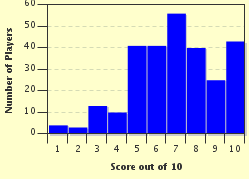Quiz Answer Key and Fun Facts
1. Which of the following is not a key physical requirement for radio announcers or Deejays?
2. In sports broadcasting the term PBP stands for which of the following?
3. Which of the following is least likely to occur if you are working too close to a microphone?
4. When a studio microphone is on, most audio consoles will automatically mute the studio audio speakers. This protects the audio signal from which of the following occurrences?
5. Which microphone has the smallest pickup pattern?
6. What would be a good mic-to-mouth distance in inches for a beginning radio announcer?
7. The broadcast standard for speaking is Standard American English at about 160 words per minute.
8. The proper use of the lips, teeth, tongue, and jaw, referred to as the _______, helps to produce clear vocal sounds.
9. Which of the following words is defined as the highness or lowness of your voice?
10. Which of the following is NOT a common vocal problem found in many broadcast announcers?
Source: Author
Treasurehunter
This quiz was reviewed by FunTrivia editor
Exit10 before going online.
Any errors found in FunTrivia content are routinely corrected through our feedback system.

